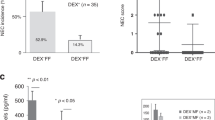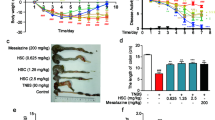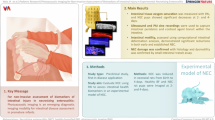Abstract
Background:
Changes in the intestinal and colonic proteome in patients with necrotizing enterocolitis (NEC) may help to characterize the disease pathology and identify new biomarkers and treatment targets for NEC.
Methods:
Using gel-based proteomics, proteins in NEC-affected intestinal and colonic sections were compared with those in adjacent, near-normal tissue sections within the same patients. Western blot and immunohistochemistry were applied to crossvalidate proteomic data and histological location of some selected proteins.
Results:
Thirty proteins were identified with differential expression between necrotic and vital small-intestine sections and 23 proteins were identified for colon sections. Five proteins were similarly affected in the small intestine and colon: histamine receptors (HRs), actins, globins, immunoglobulin, and antitrypsin. Two heat shock proteins (HSPs) were affected in the small intestine. Furthermore, proteins involved in antioxidation, angiogenesis, cytoskeleton formation, and metabolism were affected. Finally, secretory proteins such as antitrypsin, fatty-acid binding protein 5, and haptoglobin differed between NEC-affected and vital tissues.
Conclusion:
NEC progression affects different pathways in the small intestine and colon. HSPs may play an important role, especially in the small intestine. The identified secretory proteins should be investigated as possible circulating markers of NEC progression in different gut regions.
Similar content being viewed by others
Log in or create a free account to read this content
Gain free access to this article, as well as selected content from this journal and more on nature.com
or
References
Obladen M . Necrotizing enterocolitis–150 years of fruitless search for the cause. Neonatology 2009;96:203–10.
Hsueh W, Caplan MS, Qu XW, Tan XD, De Plaen IG, Gonzalez-Crussi F . Neonatal necrotizing enterocolitis: clinical considerations and pathogenetic concepts. Pediatr Dev Pathol 2003;6:6–23.
Berseth CL . Feeding strategies and necrotizing enterocolitis. Curr Opin Pediatr 2005;17:170–3.
Sangild PT, Siggers RH, Schmidt M, et al. Diet- and colonization-dependent intestinal dysfunction predisposes to necrotizing enterocolitis in preterm pigs. Gastroenterology 2006;130:1776–92.
Bjornvad CR, Thymann T, Deutz NE, et al. Enteral feeding induces diet-dependent mucosal dysfunction, bacterial proliferation, and necrotizing enterocolitis in preterm pigs on parenteral nutrition. Am J Physiol Gastrointest Liver Physiol 2008;295:G1092–103.
Jiang P, Sangild PT, Sit WH, et al. Temporal proteomic analysis of intestine developing necrotizing enterocolitis following enteral formula feeding to preterm pigs. J Proteome Res 2009;8:72–81.
Jiang P, Siggers JLA, Ngai HH-Y, et al. The small intestine proteome is changed in preterm pigs developing necrotizing enterocolitis in response to formula feeding. J Nutr 2008;60:1491–9.
Jiang P, Sangild PT, Siggers RH, Sit WH, Lee CL, Wan JM . Bacterial colonization affects the intestinal proteome of preterm pigs susceptible to necrotizing enterocolitis. Neonatology 2011;99:280–8.
Takagaki K, Osawa S, Horio Y, et al. Cytokine responses of intraepithelial lymphocytes are regulated by histamine H(2) receptor. J Gastroenterol 2009;44:285–96.
Schultheiss G, Hennig B, Schunack W, Prinz G, Diener M . Histamine-induced ion secretion across rat distal colon: involvement of histamine H1 and H2 receptors. Eur J Pharmacol 2006;546:161–70.
Faust D, Raschke K, Hormann S, Milovic V, Stein J . Regulation of alpha1-proteinase inhibitor release by proinflammatory cytokines in human intestinal epithelial cells. Clin Exp Immunol 2002;128:279–84.
Balch WE, Morimoto RI, Dillin A, Kelly JW . Adapting proteostasis for disease intervention. Science 2008;319:916–9.
Shkoda A, Ruiz PA, Daniel H, et al. Interleukin-10 blocked endoplasmic reticulum stress in intestinal epithelial cells: impact on chronic inflammation. Gastroenterology 2007;132:190–207.
Werner T, Haller D . Intestinal epithelial cell signalling and chronic inflammation: From the proteome to specific molecular mechanisms. Mutat Res 2007;622:42–57.
Patil SB, Bitar KN . RhoA- and PKC-alpha-mediated phosphorylation of MYPT and its association with HSP27 in colonic smooth muscle cells. Am J Physiol Gastrointest Liver Physiol 2006;290:G83–95.
Freire F, Romão MJ, Macedo AL, Aveiro SS, Goodfellow BJ, Carvalho AL . Preliminary structural characterization of human SOUL, a haem-binding protein. Acta Crystallogr Sect F Struct Biol Cryst Commun 2009;65(Pt 7):723–6.
Sedlak TW, Saleh M, Higginson DS, Paul BD, Juluri KR, Snyder SH . Bilirubin and glutathione have complementary antioxidant and cytoprotective roles. Proc Natl Acad Sci USA 2009;106:5171–6.
Nakao A, Otterbein LE, Overhaus M, et al. Biliverdin protects the functional integrity of a transplanted syngeneic small bowel. Gastroenterology 2004;127:595–606.
Jiménez A, Pelto-Huikko M, Gustafsson JA, Miranda-Vizuete A . Characterization of human thioredoxin-like-1: potential involvement in the cellular response against glucose deprivation. FEBS Lett 2006;580:960–7.
Andersen KM, Madsen L, Prag S, et al. Thioredoxin Txnl1/TRP32 is a redox-active cofactor of the 26 S proteasome. J Biol Chem 2009;284:15246–54.
Chae HZ, Robison K, Poole LB, Church G, Storz G, Rhee SG . Cloning and sequencing of thiol-specific antioxidant from mammalian brain: alkyl hydroperoxide reductase and thiol-specific antioxidant define a large family of antioxidant enzymes. Proc Natl Acad Sci USA 1994;91:7017–21.
Sato D, Yanaka A, Shibahara T, et al. Peroxiredoxin I protects gastric mucosa from oxidative injury induced by H. pylori infection. J Gastroenterol Hepatol 2008;23:652–9.
Ishii T, Itoh K, Akasaka J, et al. Induction of murine intestinal and hepatic peroxiredoxin MSP23 by dietary butylated hydroxyanisole. Carcinogenesis 2000;21:1013–6.
Naydenov NG, Hopkins AM, Ivanov AI . c-Jun N-terminal kinase mediates disassembly of apical junctions in model intestinal epithelia. Cell Cycle 2009;8:2110–21.
Chakravortty D, Nanda Kumar KS . Bacterial lipopolysaccharide induces cytoskeletal rearrangement in small intestinal lamina propria fibroblasts: actin assembly is essential for lipopolysaccharide signaling. Biochim Biophys Acta 2000;1500:125–36.
Habtezion A, Toivola DM, Asghar MN, et al. Absence of keratin 8 confers a paradoxical microflora-dependent resistance to apoptosis in the colon. Proc Natl Acad Sci USA 2011;108:1445–50.
Cirillo P, Gersch MS, Mu W, et al. Ketohexokinase-dependent metabolism of fructose induces proinflammatory mediators in proximal tubular cells. J Am Soc Nephrol 2009;20:545–53.
Schrick JJ, Lingrel JB . cDNA cloning, mapping and expression of the mouse propionyl CoA carboxylase beta (pccb), the gene for human type II propionic acidaemia. Gene 2001;264:147–52.
Camarero N, Mascaró C, Mayordomo C, Vilardell F, Haro D, Marrero PF . Ketogenic HMGCS2 Is a c-Myc target gene expressed in differentiated cells of human colonic epithelium and down-regulated in colon cancer. Mol Cancer Res 2006;4:645–53.
Snyder CH, Merbitz-Zahradnik T, Link TA, Trumpower BL . Role of the Rieske iron-sulfur protein midpoint potential in the protonmotive Q-cycle mechanism of the cytochrome bc1 complex. J Bioenerg Biomembr 1999;31:235–42.
Guthmann F, Börchers T, Wolfrum C, Wustrack T, Bartholomäus S, Spener F . Plasma concentration of intestinal- and liver-FABP in neonates suffering from necrotizing enterocolitis and in healthy preterm neonates. Mol Cell Biochem 2002;239:227–34.
Volakakis N, Joodmardi E, Perlmann T . NR4A orphan nuclear receptors influence retinoic acid and docosahexaenoic acid signaling via up-regulation of fatty acid binding protein 5. Biochem Biophys Res Commun 2009;390:1186–91.
Kreunin P, Zhao J, Rosser C, Urquidi V, Lubman DM, Goodison S . Bladder cancer associated glycoprotein signatures revealed by urinary proteomic profiling. J Proteome Res 2007;6:2631–9.
Tian M, Cui YZ, Song GH, et al. Proteomic analysis identifies MMP-9, DJ-1 and A1BG as overexpressed proteins in pancreatic juice from pancreatic ductal adenocarcinoma patients. BMC Cancer 2008;8:241.
Insenser M, Martínez-García MA, Montes R, San-Millán JL, Escobar-Morreale HF . Proteomic analysis of plasma in the polycystic ovary syndrome identifies novel markers involved in iron metabolism, acute-phase response, and inflammation. J Clin Endocrinol Metab 2010;95:3863–70.
Tripathi A, Lammers KM, Goldblum S, et al. Identification of human zonulin, a physiological modulator of tight junctions, as prehaptoglobin-2. Proc Natl Acad Sci USA 2009;106:16799–804.
Obchoei S, Wongkhan S, Wongkham C, Li M, Yao Q, Chen C . Cyclophilin A: potential functions and therapeutic target for human cancer. Med Sci Monit 2009;15:RA221–32.
Danese S . Negative regulators of angiogenesis in inflammatory bowel disease: thrombospondin in the spotlight. Pathobiology 2008;75:22–4.
Punekar S, Zak S, Kalter VG, et al. Thrombospondin 1 and its mimetic peptide ABT-510 decrease angiogenesis and inflammation in a murine model of inflammatory bowel disease. Pathobiology 2008;75:9–21.
Smith B, Bodé S, Petersen BL, et al. Community analysis of bacteria colonizing intestinal tissue of neonates with necrotizing enterocolitis. BMC Microbiol 2011;11:73.
Acknowledgements
We thank Steffen Husby at the Pediatric Department of University of South Western Denmark, Odense, Denmark; Annie Ravn Pedersen at the National Veterinary Institute; and Karen A. Krogfelt of State Serum Institute, Copenhagen, Denmark, for their support. We also thank Kwong-Leung Chan at Queen Mary Hospital, the University of Hong Kong, Hong Kong SAR, China, for his intellectual contribution to this study.
Author information
Authors and Affiliations
Corresponding author
Rights and permissions
About this article
Cite this article
Jiang, P., Smith, B., Qvist, N. et al. Intestinal proteome changes during infant necrotizing enterocolitis. Pediatr Res 73, 268–276 (2013). https://doi.org/10.1038/pr.2012.182
Received:
Accepted:
Published:
Issue date:
DOI: https://doi.org/10.1038/pr.2012.182
This article is cited by
-
Necrotizing enterocolitis: current understanding of the prevention and management
Pediatric Surgery International (2024)



